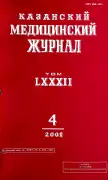Ultrasonography of diseases of bone and muscular system
- Authors: Klyushkin I.V.1,2, Pasynkov D.V.1,2, Tikhonov V.A.1,2, Nafikov G.A.1,2, Tazeev R.R.1,2
-
Affiliations:
- Kazan State Medical University
- Kazan Military Hospital
- Issue: Vol 82, No 4 (2001)
- Pages: 260-265
- Section: Articles
- URL: https://journals.rcsi.science/kazanmedj/article/view/83854
- DOI: https://doi.org/10.17816/kazmj83854
- ID: 83854
Cite item
Full Text
Abstract
As many as 1500 patients with various pathology of bone and muscular system were examined. The comparative study of traditional roentgenography, ultrasound examination, computer and magnetoresonance tomography was carried out to determine the optimum application in examining bone and muscular system. In many cases of the bone and muscular system diseases (bone fractures, osteomyelitis, bone tumors, soft tissue fistulas) the ultrasound examination successfully competes with other methods and in some cases, it is the method of choice.
Keywords
Full Text
##article.viewOnOriginalSite##About the authors
I. V. Klyushkin
Kazan State Medical University; Kazan Military Hospital
Email: info@eco-vector.com
Russian Federation
D. V. Pasynkov
Kazan State Medical University; Kazan Military Hospital
Email: info@eco-vector.com
Russian Federation
V. A. Tikhonov
Kazan State Medical University; Kazan Military Hospital
Author for correspondence.
Email: info@eco-vector.com
Russian Federation
G. A. Nafikov
Kazan State Medical University; Kazan Military Hospital
Email: info@eco-vector.com
Russian Federation
R. R. Tazeev
Kazan State Medical University; Kazan Military Hospital
Email: info@eco-vector.com
Russian Federation
References
Supplementary files



















